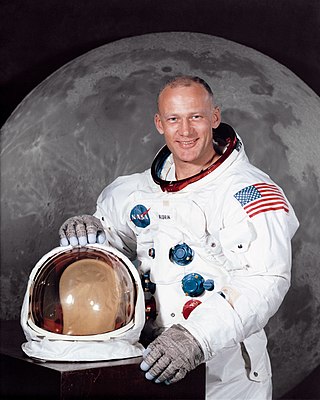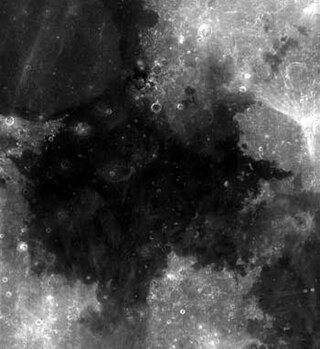Related Research Articles

Apollo 11 was the American spaceflight that first landed humans on the Moon. Commander Neil Armstrong and Lunar Module Pilot Buzz Aldrin landed the Apollo Lunar Module Eagle on July 20, 1969, at 20:17 UTC, and Armstrong became the first person to step onto the Moon's surface six hours and 39 minutes later, on July 21 at 02:56 UTC. Aldrin joined him 19 minutes later, and they spent about two and a quarter hours together exploring the site they had named Tranquility Base upon landing. Armstrong and Aldrin collected 47.5 pounds (21.5 kg) of lunar material to bring back to Earth as pilot Michael Collins flew the Command Module Columbia in lunar orbit, and were on the Moon's surface for 21 hours, 36 minutes before lifting off to rejoin Columbia.

Neil Alden Armstrong was an American astronaut and aeronautical engineer who in 1969 became the first person to walk on the Moon. He was also a naval aviator, test pilot, and university professor.

Buzz Aldrin is an American former astronaut, engineer and fighter pilot. He made three spacewalks as pilot of the 1966 Gemini 12 mission. He was the Lunar Module Eagle pilot on the 1969 Apollo 11 mission and became the second person to walk on the Moon after mission commander Neil Armstrong.

Moon landing conspiracy theories claim that some or all elements of the Apollo program and the associated Moon landings were hoaxes staged by NASA, possibly with the aid of other organizations. The most notable claim is that the six crewed landings (1969–1972) were faked and that twelve Apollo astronauts did not actually walk on the Moon. Various groups and individuals have made claims since the mid-1970s that NASA and others knowingly misled the public into believing the landings happened, by manufacturing, tampering with, or destroying evidence including photos, telemetry tapes, radio and TV transmissions, and Moon rock samples.

Michael Collins was an American astronaut who flew the Apollo 11 command module Columbia around the Moon in 1969 while his crewmates, Neil Armstrong and Buzz Aldrin, made the first crewed landing on the surface. He was also a test pilot and major general in the U.S. Air Force Reserve.

Mare Tranquillitatis is a lunar mare that sits within the Tranquillitatis basin on the Moon. It is the first location on another celestial body to be visited by humans.

Bart Winfield Sibrel is an American conspiracy theorist who has written, produced, and directed works in support of the false belief that the Apollo Moon landings between 1969 and 1972 were staged by NASA under the control of the CIA. He has written, produced, and directed four independent films promoting the ideas, with the first being the 2001 film A Funny Thing Happened on the Way to the Moon. In his works, Sibrel in part films himself asking that various Apollo astronauts put their hand on the Bible and swear an oath that they walked on the Moon. In the case of the Apollo 11 astronaut Buzz Aldrin, whom Sibrel arranged to meet on a false pretense, outside the Luxe Hotel in Beverly Hills, the interaction resulted in Aldrin punching Sibrel, which brought him significant publicity. However, no criminal charges were filed against Aldrin.

Aldrin is a small impact crater located on the southern part of the Mare Tranquillitatis, to the east of Sabine. It is located about 50 kilometers to the northwest of the Apollo 11 landing site, Tranquility Base. Named after Buzz Aldrin, the crater is the westernmost of a row of three craters named in honor of the Apollo 11 crew members. About 30 kilometers to the east is the landing site of the Surveyor 5 lunar probe.

Armstrong is a small lunar impact crater located in the southern part of the Mare Tranquillitatis. It lies about 50 kilometers to the northeast of the Apollo 11 landing site, Tranquility Base. Named after American astronaut Neil Armstrong, the crater is the easternmost of the row of three craters named in honor of the Apollo 11 crew members. To the north is the Ranger 8 impact site.

Collins is a tiny lunar impact crater located on the southern part of the Mare Tranquillitatis. It is located about 25 kilometers to the north of the Apollo 11 landing site, Tranquility Base. Named after American astronaut Michael Collins, the crater is the central member of the row of three craters named in honor of the Apollo 11 crew members. About 15 kilometers to the west-northwest is the landing site of the Surveyor 5 lunar probe.

Tranquility Base is the site on the Moon where, in July 1969, humans landed and walked on a celestial body other than Earth for the first time. On July 20, 1969, Apollo 11 crewmembers Neil Armstrong and Buzz Aldrin landed their Apollo Lunar Module Eagle at approximately 20:17:40 UTC. Armstrong exited the spacecraft six hours and 39 minutes after touchdown, followed 19 minutes later by Aldrin. The astronauts spent two hours and 31 minutes examining and photographing the lunar surface, setting up several scientific experiment packages, and collecting 47.5 pounds (21.5 kg) of dirt and rock samples for return to Earth. They lifted off the surface on July 21 at 17:54 UTC.

Apollo 11 was the first human spaceflight to land on the Moon. The 1969 mission's wide effect on popular culture has resulted in numerous portrayals of Apollo 11 and its crew, Neil Armstrong, Buzz Aldrin, and Michael Collins.
Astronauts Gone Wild: Investigation Into the Authenticity of the Moon Landings is a 2004 documentary video produced and directed by Bart Sibrel, a Nashville, Tennessee-based video maker who charges that the six Apollo Moon landings in the 1960s and 1970s were elaborate hoaxes. Sibrel made this video as a follow-up to his 2001 video A Funny Thing Happened on the Way to the Moon, which accuses NASA of falsifying the Apollo 11 mission photography. The title of the presentation is a wordplay on the Girls Gone Wild video series.
Apogee Books is an imprint of Canadian publishing house Collector's Guide Publishing. The Apogee imprint began with "Apollo 8 The NASA Mission Reports" in November 1998 at the request of astronaut Buzz Aldrin, second man on the moon. The first publication by Apogee was printed to celebrate the 30th anniversary of the first crewed flight around the moon. A limited edition print run of this Apollo 8 book led to Aldrin suggesting that the imprint continue with further anniversary publications.
Moon Landing is a musical with book, lyrics and music by Stephen Edwards. The story, from an original idea and synopsis by Justin Fleming, is based on the American Space Race and the Apollo 11 spaceflight which on July 20, 1969 landed the first humans on the Moon and is seen through the eyes of Buzz Aldrin, the second man to walk on the Moon.
Apollo 11 is a television docudrama film which aired on November 17, 1996 on The Family Channel. It was nominated for a Primetime Emmy.

The Lunar Flag Assembly (LFA) was a kit containing a flag of the United States designed to be erected on the Moon during the Apollo program. Six such flag assemblies were planted on the Moon. The nylon flags were hung on telescoping staffs and horizontal bars constructed of one-inch anodized aluminum tubes. The flags were carried on the outside of the Apollo Lunar Module (LM), most of them on the descent ladder inside a thermally insulated tubular case to protect them from exhaust gas temperatures calculated to reach 2,000 °F (1,090 °C). The assembly was designed and supervised by Jack Kinzler, head of technical services at the Manned Spacecraft Center (MSC) in Houston, Texas. Six of the flags were ordered from a government supply catalog and measured 3 by 5 feet ; the last one planted on the Moon was the slightly larger, 6-foot (1.8 m)-wide flag which had hung in the MSC Mission Operations Control Room for most of the Apollo program.

Apollo 11 was the first human spaceflight to land on the Moon. In the decades after its 1969 mission took place, widespread celebrations have been held to celebrate its anniversaries.

Lunar Module Eagle (LM-5) is the spacecraft that served as the crewed lunar lander of Apollo 11, which was the first mission to land humans on the Moon. It was named after the bald eagle, which was featured prominently on the mission insignia. It flew from Earth to lunar orbit on the command module Columbia, and then was flown to the Moon on July 20, 1969, by astronaut Neil Armstrong with navigational assistance from Buzz Aldrin. Eagle's landing created Tranquility Base, named by Armstrong and Aldrin and first announced upon the module's touchdown.